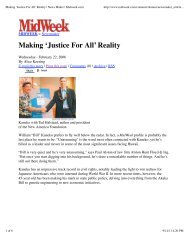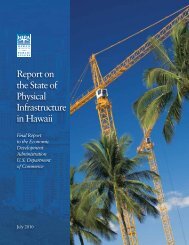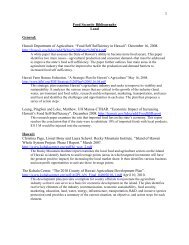Hawai'i Fisheries Initiative - The Hawaii Institute for Public Affairs
Hawai'i Fisheries Initiative - The Hawaii Institute for Public Affairs
Hawai'i Fisheries Initiative - The Hawaii Institute for Public Affairs
Create successful ePaper yourself
Turn your PDF publications into a flip-book with our unique Google optimized e-Paper software.
Waters: Native <strong>Hawaii</strong>ans have an interest in the<br />
living and nonliving resources of submerged<br />
lands and offshore water in the exclusive<br />
economic zones and territorial seas surrounding<br />
the <strong>Hawaii</strong>an Islands, Johnston Atoll, Palmyra<br />
Island, and Midway Island. Native <strong>Hawaii</strong>ans are<br />
entitled to half of all revenues received by the<br />
U.S. government from these resources. Native<br />
<strong>Hawaii</strong>ans are also entitled to harvest half of<br />
all resources in these areas. Both the living and<br />
nonliving resources should be co-managed by<br />
appropriate federal and state agencies and OHA,<br />
or any successor Native <strong>Hawaii</strong>an entity developed<br />
pursuant to the process set <strong>for</strong>th below, in an<br />
environmentally sensitive manner designed to<br />
preserve these resources <strong>for</strong> future generations.”<br />
517 <strong>Public</strong> Access Shoreline Hawai‘i (PASH) v. Hawai‘i<br />
County Planning Commission, 79 Hawai‘i 425,<br />
903 P.2d 1246 (1995), cert. denied, 116 S. Ct. 1559<br />
(1996) (Mem.).<br />
518 D. Kapua Sproat, <strong>The</strong> backlash against PASH:<br />
legislative attempts to restrict Native <strong>Hawaii</strong>an<br />
rights, 20 U. Haw. L. Rev. 321 (1998), citing <strong>Public</strong><br />
Access Shoreline Hawai‘i (PASH) v. Hawai‘i County<br />
Planning Commission, 79 Hawai‘i 425, at 448. See<br />
also Ian H. Hlawati, “LOKO I‘A: A LEGAL GUIDE<br />
TO THE RESTORATION OF NATIVE HAWAIIAN<br />
FISHPONDS WITHIN THE WESTERN PARADIGM,”<br />
24 U. Haw. L. Rev. 657 (2002), citing Carol Araki<br />
Wyban, Tide and Current: Fishponds of Hawai‘i<br />
xiii (1992); Joseph M. Farber, Ancient <strong>Hawaii</strong>an<br />
Fishponds: Can Restoration Succeed on Moloka‘i?<br />
1-5 (1997); 79 Hawai‘i 425, <strong>Public</strong> Access Shoreline<br />
Hawai‘i v. Hawai‘i County Planning Commission,<br />
903 P.2d 1246 (1995), cert denied, 517 U.S. 1163<br />
(1996), at 447. Also: D. Kapua Sproat, Comment,<br />
<strong>The</strong> Backlash Against PASH: Legislative Attempts to<br />
Restrict Native <strong>Hawaii</strong>an Rights, 20 U. Haw. L. Rev.<br />
321, 338 (1998), citing Kalipi v. <strong>Hawaii</strong>an Trust<br />
Co., 66 Haw. 1, 5, 656 P.2d 745, 748 (1982) <strong>for</strong> the<br />
proposition that Hawai‘i Revised Statutes (“HRS”)<br />
section 7-1 confers rights of access, gathering<br />
and water); see also PASH, 79 Hawai‘i at 445-46,<br />
903 P.2d at 1266-67 (examining earlier codified<br />
protection of tenant gathering rights after the<br />
Great Mahele, wherein the Hawai‘i Supreme Court<br />
quoted a Privy Council resolution, which states, in<br />
pertinent part, “the rights of the makaainanas to<br />
firewood, timber <strong>for</strong> house, grass <strong>for</strong> thatching, ki<br />
leaf, water <strong>for</strong> household purposes in said land . . .<br />
is hereby sacredly reserved and confirmed to them<br />
<strong>for</strong> their private use . . . .” (citing 3B Privy Council<br />
Records 681, 687 (1850) (emphasis added).<br />
519 D. Kapua Sproat, <strong>The</strong> backlash against PASH:<br />
legislative attempts to restrict Native <strong>Hawaii</strong>an<br />
rights, 20 U. Haw. L. Rev. 321 (1998), citing <strong>Public</strong><br />
Access Shoreline Hawai‘i (PASH) v. Hawai‘i County<br />
Planning Commission, 79 Hawai‘i 425, at 437.<br />
520 D. Kapua Sproat, <strong>The</strong> backlash against PASH:<br />
legislative attempts to restrict Native <strong>Hawaii</strong>an<br />
rights, 20 U. Haw. L. Rev. 321 (1998), citing <strong>Public</strong><br />
Access Shoreline Hawai‘i (PASH) v. Hawai‘i County<br />
Planning Commission, 79 Hawai‘i 425, at 447-51.<br />
521 Report of the Waitangi Tribunal on the<br />
Muriwhenua Fishing Claim (1988) at http://<br />
www.waitangitribunal.govt.nz/scripts/<br />
reports/reports/22/796C25F5-7F61-4F4F-8C50-<br />
EED0218276F3.pdf, p. 5-8.<br />
522 “Our Sea of Islands: A Regional Forum <strong>for</strong> Oceania<br />
on marine Managed Areas and World Heritage,”<br />
January 29-February 2, 2007, Honolulu, Hawai‘i.<br />
Final documents at http://www.hawaiireef.noaa.<br />
gov/news/events/OurSeaofIslands.html.<br />
523 Alan Friedlander, Bob Endreson, William Aila, Linda<br />
Paul, with the assistance of DAR, Pacific <strong>Fisheries</strong><br />
Coalition whitepaper, <strong>The</strong> Status of Hawai‘i’s Living<br />
Marine Resources at the Millennium, at http://<br />
www.pacfish.org/wpapers/fishstatus.html.<br />
524 Id.<br />
525 <strong>The</strong> Nature Conservancy Hawai‘i, Makai Watch<br />
program, at http://www.nature.org/wherewework/<br />
northamerica/states/hawaii/marine/art20999.html.<br />
526 NOAA Pacific Services Center, at www.csc.noaa.<br />
gov/psc/strategic.html; (808) 532-3200.<br />
527 MSA § 301(a)(8). National Standard 8: “Conservation<br />
and management measures shall, consistent<br />
with the conservation requirements of this Act<br />
(including the prevention of overfishing and<br />
rebuilding of overfished stocks), take into account<br />
the importance of fishery resources to fishing<br />
communities in order to (A) provide <strong>for</strong> the<br />
sustained participation of such communities, and<br />
(B) to the extent practicable, minimize adverse<br />
economic impacts on such communities.”<br />
528 See R. Iversen, T. Dye, and L. M. B. Paul. 1989.<br />
Rights of Native <strong>Hawaii</strong>an fishermen with<br />
specific regard to harvesting bottomfish in the<br />
Northwestern <strong>Hawaii</strong>an Islands and with regard to<br />
harvesting bottomfish, crustaceans, precious corals,<br />
and open-ocean fish in offshore areas surrounding<br />
the entire <strong>Hawaii</strong>an island chain. A report<br />
prepared <strong>for</strong> the Western Pacific Regional Fishery<br />
Management Council. Honolulu, Hawai‘i.<br />
529 Wespac, Building community networks in the<br />
western Pacific region, March 2007.<br />
530 Kitty Simonds, Wespac executive director,<br />
welcoming remarks at Ho‘ohanohano I Na Kupuna<br />
Puwalu, December 2006.<br />
531 Leimana DaMate, Chair, Association of <strong>Hawaii</strong>an<br />
Civic Clubs Ocean Resources Committee, Status<br />
report on ocean and ecosystem issues, October<br />
23, 2006, at http://www.aohcc.org/Committee%20<br />
Reports/2006/Ocean%20Resources%20Att%202.doc.<br />
532 Ho‘ohanohano I Na Kupuna Puwalu, August 2006.<br />
A gathering of expert Native <strong>Hawaii</strong>an cultural and<br />
practitioners versed in lawai’a and mahiai – ocean<br />
and land ahupua‘a methods; at http://www.aohcc.<br />
org/Committee%20Reports/Summary.doc.<br />
533 Hawai‘i Ocean Resources Management Plan 2006,<br />
HRS § 205A, at http://www.<strong>Hawaii</strong>.gov/dbedt/<br />
main/about/leg-reports/ormp-final-2006.pdf,<br />
page 8. Traditionally in Hawai‘i, natural resources<br />
were managed at the ahupua‘a and moku levels.<br />
‘Aha Councils, composed of a diverse group<br />
of practitioners and acknowledged experts in<br />
agriculture, fishing, water resources, and cultural<br />
skills, lived within each ahupua‘a and served<br />
together as the governing board. Today, in contrast,<br />
Hawai‘i’s legal and institutional framework <strong>for</strong><br />
environmental and natural resources management<br />
largely perpetuates a sector-based approach where<br />
different government agencies have jurisdictional<br />
authority over specific resources. Increasing pressure<br />
on natural resources coupled with a greater understanding<br />
of environmental systems have brought<br />
to light the need <strong>for</strong> a more holistic approach to<br />
natural resource management. <strong>The</strong> management<br />
goals and strategic actions described under this<br />
perspective provide opportunities to demonstrate<br />
integrated natural resources management<br />
approaches, build capacity <strong>for</strong> community participation<br />
and stewardship, and develop legal and<br />
policy proposals to institutionalize integrated and<br />
collaborative management approaches.<br />
124







